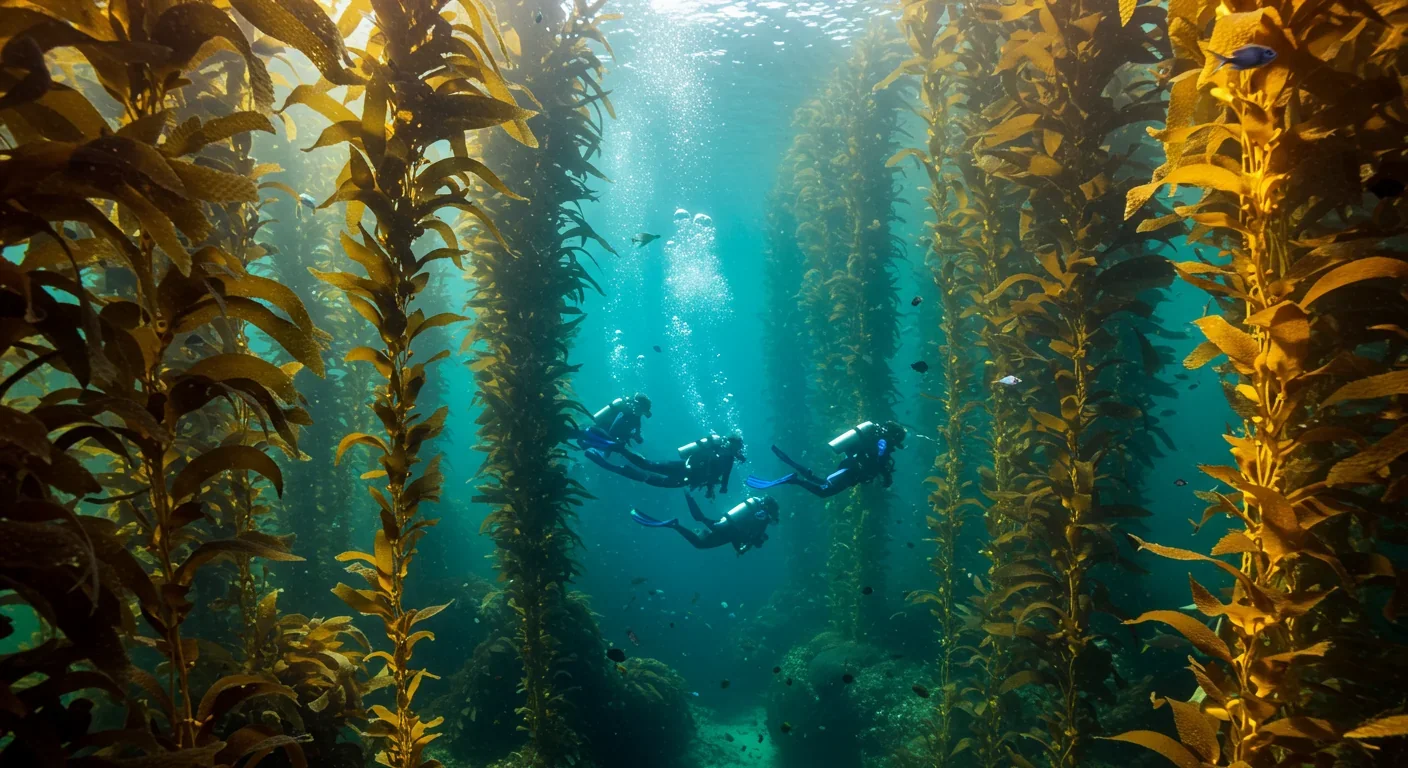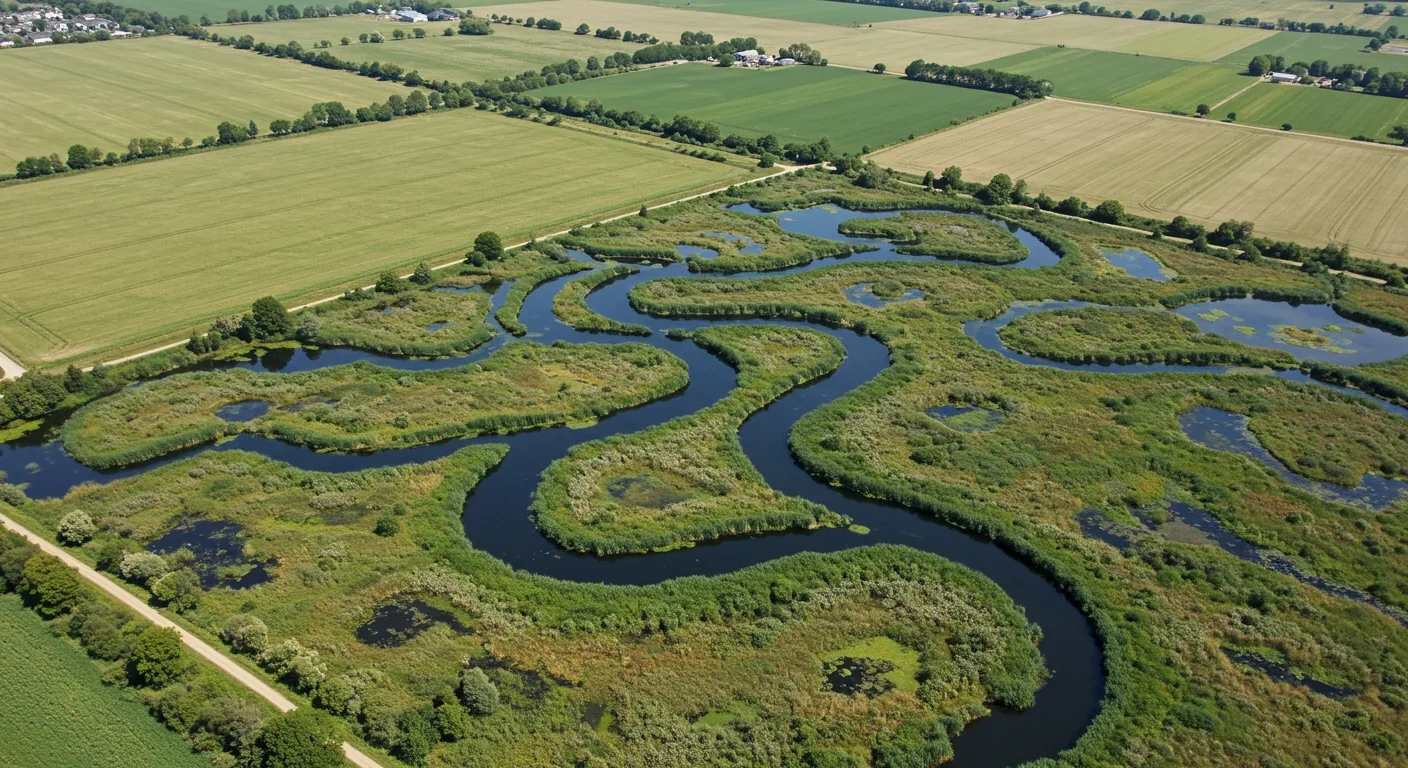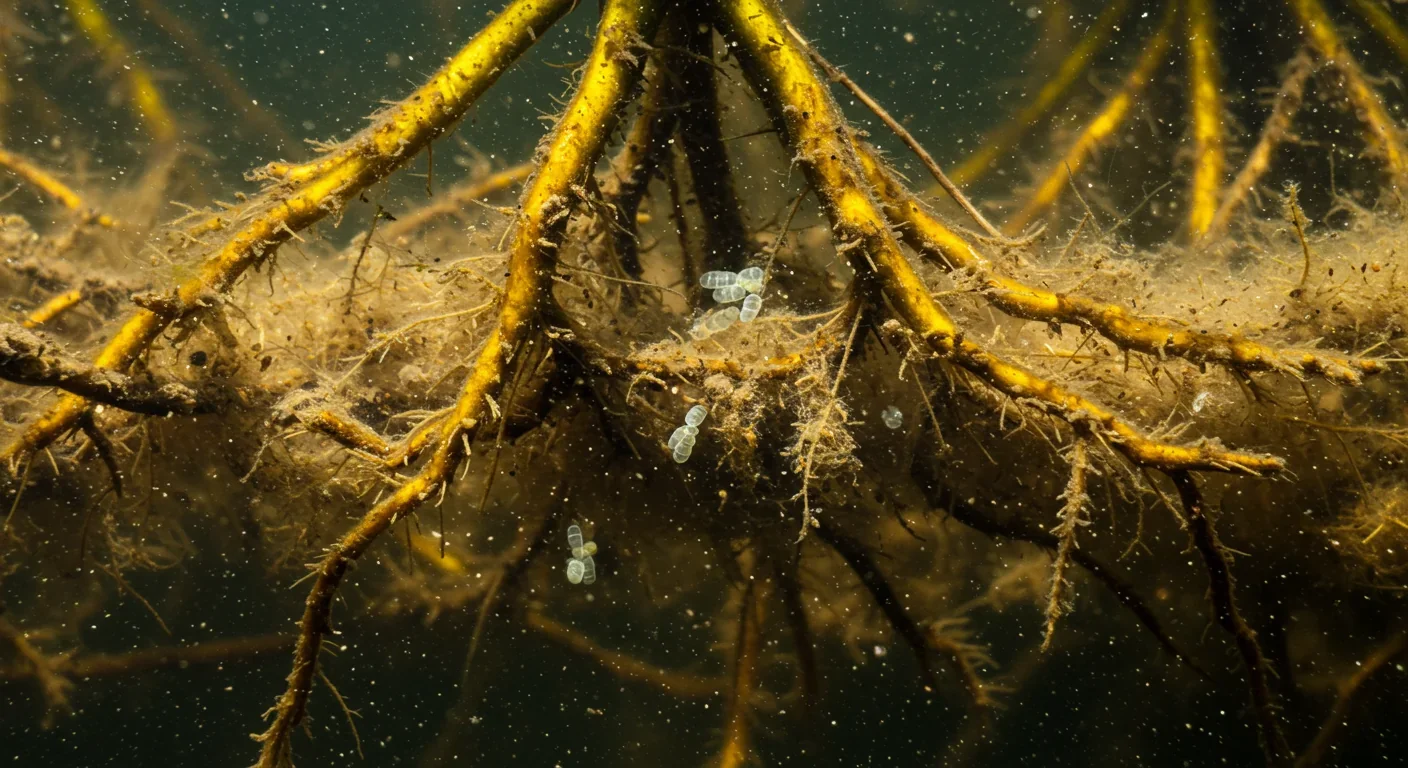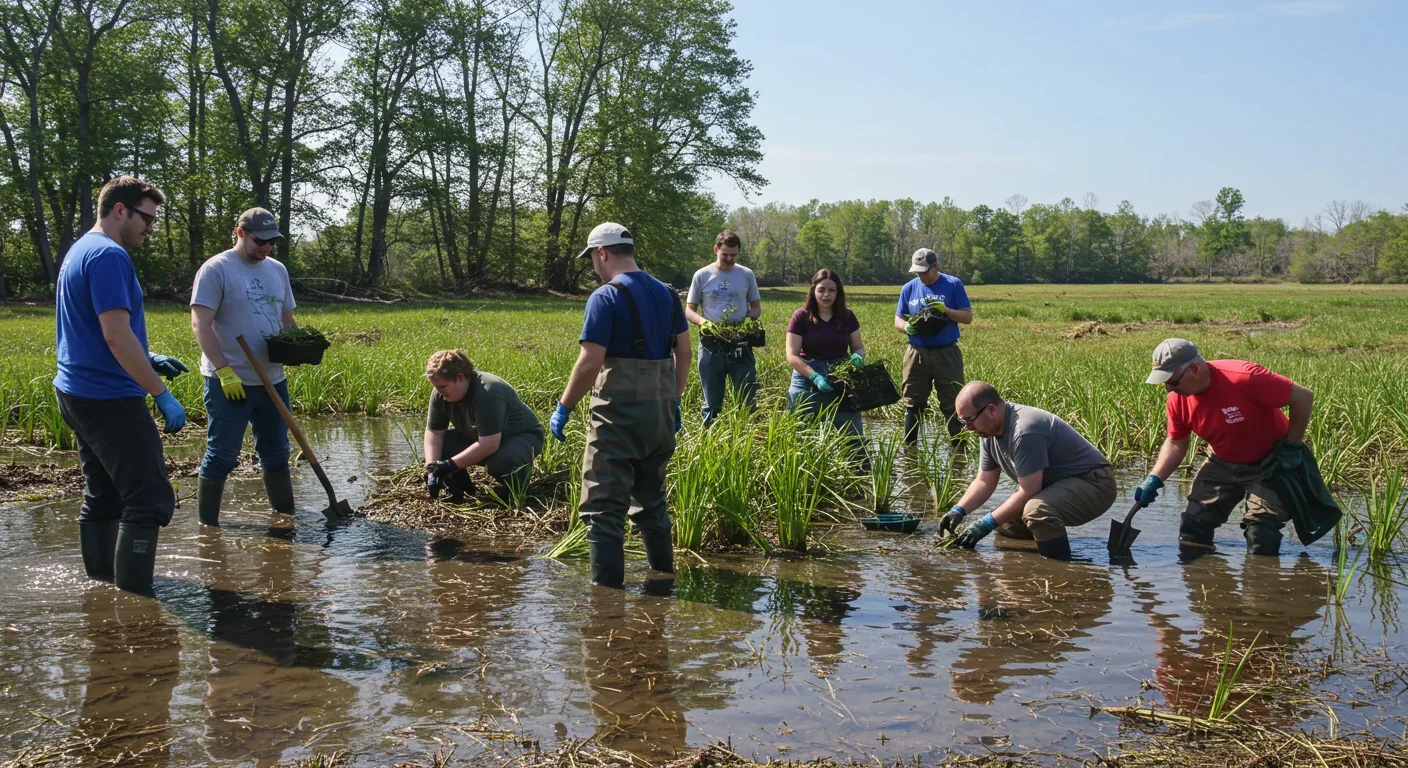Kelp Forests and Climate Change: Marine Permaculture Guide

TL;DR: Wetlands are nature's most cost-effective water purification systems, removing 70-90% of pollutants at 30-50% lower costs than conventional treatment. From Florida's 57,000-acre Everglades restoration to Indonesian community mangrove projects, these ecosystems simultaneously clean water, sequester carbon, buffer floods, and support biodiversity. While challenges like land competition, climate impacts, and equity concerns persist, the evidence is clear: restored wetlands appreciate over time, making them investments rather than expenses for communities ready to work with natural systems instead of against them.

Within the next decade, you'll likely see your local government invest millions in a technology that costs 30–50% less than traditional infrastructure, removes up to 90% of pollutants, and grows more effective every year. This isn't a Silicon Valley innovation—it's a system that's been perfecting itself for millennia. Wetlands, once dismissed as wastelands to be drained and developed, are now recognized as nature's most sophisticated water purification systems. From the Florida Everglades to Indonesian mangroves, communities worldwide are rediscovering that restoring these ecosystems doesn't just clean water—it transforms economies, protects coastlines, and builds resilience against climate change.
In 2021, EPA scientists analyzing Florida's Everglades made a startling discovery: 57,000 acres of engineered treatment wetlands—called Stormwater Treatment Areas—were reducing phosphorus concentrations from 80 parts per billion to just 10 ppb before water entered protected habitats. This $2 billion restoration effort has proven more cost-effective than conventional water treatment while simultaneously creating habitat for endangered species and drawing millions of ecotourism dollars annually.
The numbers tell a remarkable story. Constructed wetlands achieve 70–90% removal rates for heavy metals and nutrients while operating at 30–50% lower costs than conventional treatment plants. In tidal-flow systems optimized with step-feeding strategies, nitrogen removal reaches 81%, with chemical oxygen demand dropping by 95%. These aren't theoretical laboratory results—they're real-world outcomes from systems treating millions of gallons daily.
What makes this revolution particularly significant is that wetlands improve with age, unlike built infrastructure that depreciates. A mature saltmarsh or mangrove system stores three times more carbon than a newly restored site, while its water purification capacity continues increasing as root systems expand and microbial communities mature. This appreciation curve fundamentally changes the economics of water infrastructure: wetlands are investments, not expenses.
Just as the printing press transformed information access, wetland restoration is transforming how civilization approaches water quality. For centuries, wetlands were viewed as obstacles to progress—mosquito-breeding swamps to be drained for agriculture and development. Between 1780 and 1980, the United States lost approximately 53% of its original wetland acreage, with some states losing over 90%.
The consequences of this loss were predictable but ignored. The bottomland hardwood-riparian wetlands along the Mississippi River once stored at least 60 days of floodwater; by the late 20th century, they stored only 12 days. As wetlands vanished, water quality deteriorated, flooding intensified, and coastal communities became vulnerable to storm surges. The 1993 Mississippi floods—causing $15 billion in damage—served as a wake-up call about the cost of wetland destruction.
The reversal began slowly. The Kissimmee River Restoration Project, approved by Congress in 1992, took 40 years to complete but ultimately restored 44 miles of meandering river and 20,000 acres of floodplain wetlands. Early resistance from agricultural interests gradually gave way as evidence mounted that restored wetlands could treat runoff more cheaply than built infrastructure while providing recreational value.
By the early 2000s, the restoration movement had gained scientific rigor. The EPA's Regional Environmental Monitoring and Assessment Program (REMAP) established probability-based sampling across 2,000 square miles of the Everglades, creating the only monitoring system capable of quantitative spatial statements about ecosystem health. This data became the foundation for the 2012 Water Quality Restoration Strategies Agreement between Florida and the EPA—a policy framework now serving as a model worldwide.
The lesson from history is clear: societies that work with natural water cycles thrive; those that fight them eventually pay catastrophic costs. Indigenous communities from Indonesia to Canada have maintained wetlands for centuries, understanding what Western science is only now quantifying—that these ecosystems provide services no engineer can replicate at comparable cost.
Imagine a world where water treatment plants grow themselves, repair damage automatically, and become more efficient over time. Wetlands already operate this way through three interlocking purification mechanisms working 24/7 without electricity or chemical inputs.
Physical Filtration: The Visible Process
When water enters a wetland, the first thing that happens is visible: it slows down. Plant stems—cattails, reeds, bulrush, mangroves—create friction that can reduce water velocity by 90%. This deceleration triggers gravity's simplest effect: suspended sediments settle out.
The numbers are impressive. Tropical riverine wetlands in Ethiopia retain an average of 6,266 kilograms of total suspended solids per hectare per day. In the Everglades, vegetated areas trap sediment so effectively that you can see the transition from murky canal water to clear marsh water from an aircraft.
Plant roots contribute to this physical trapping by creating a three-dimensional matrix that stabilizes soil and prevents erosion. Mangrove root systems are particularly effective—a recent study documented a 71% reduction in microplastic concentrations as water passed through a mangrove wetland, with particles becoming trapped in the complex root network and eventually buried in accumulating sediment.
Chemical Transformation: The Invisible Work
Beneath the visible surface, wetland soils host some of Earth's most sophisticated chemistry. Here's where nitrogen—the nutrient most responsible for coastal dead zones—gets neutralized through denitrification.

The process is elegant. First, aerobic bacteria near plant roots convert ammonia to nitrate through nitrification. Then, in oxygen-poor zones just millimeters away, specialized denitrifying bacteria convert nitrate to harmless nitrogen gas that bubbles into the atmosphere. A multistage tidal-flow constructed wetland in China achieved this conversion at rates of 70–77 grams of nitrogen per cubic meter per day, maintaining 80% removal efficiency even at water temperatures averaging 11.5°C.
Phosphorus—the other major nutrient pollutant—undergoes a different transformation. Wetland soils rich in iron, aluminum, and calcium bind phosphorus through chemical precipitation and adsorption. When researchers combined air nanobubbles with aluminum-modified zeolite in wetland sediments, they achieved a 69% reduction in total phosphorus while simultaneously improving plant cadmium uptake by 17%.
Heavy metals follow a similar path. Plants like water hyacinth can remove up to 97% of metals including copper, chromium, lead, and zinc at low concentrations through bioaccumulation. The metals concentrate in plant tissues, which can be harvested and processed—turning pollution into a recoverable resource.
Biological Processing: The Microbial Workforce
The real heroes of wetland purification are invisible to the naked eye. Periphyton—the biofilm coating every underwater surface—and soil microbial communities are responsible for approximately 90% of pollutant removal. Plant uptake, despite receiving more public attention, contributes only 7–10%.
These microbial communities are astonishingly diverse and specialized. In floating wetland systems treating urban runoff, researchers documented increases in Proteobacteria, Firmicutes, Planctomycetes, Bacteroidetes, and Chloroflexi populations, with key genera driving nitrogen removal through overlapping nitrification, denitrification, and anammox pathways.
The microbial ecology becomes even more interesting when you zoom in. Plant roots don't just provide surface area—they actively shape microbial communities through radial oxygen loss and carbon exudation. Wetland plants release oxygen from their roots, creating micro-aerobic zones that support nitrifying bacteria, while simultaneously exuding sugars and organic acids that fuel denitrifiers. This synergy increases nitrogen removal by up to 30% compared to systems with only plants or only microbes.
Recent discoveries have revealed even more sophisticated interactions. When earthworms were introduced to constructed wetlands treating pharmaceutical-contaminated water, microplastic removal increased by 13.5%, chemical oxygen demand dropped an additional 8.4%, and nitrogen removal improved by 9.7%. The earthworms restructured their gut microbiomes in response to pollution, enriching Actinobacteria populations specialized in polymer degradation—essentially recruiting a mobile microbial workforce to enhance treatment.
While Silicon Valley debates artificial intelligence, researchers in Tokyo, Beijing, and Jakarta are documenting how wetland restoration addresses multiple converging crises simultaneously. The same acre of restored marsh that purifies water also sequesters carbon, buffers storm surges, provides wildlife habitat, and supports fisheries—a portfolio of services no single technology can match.
Economic Disruption on the Horizon
The water treatment industry—a $50 billion global market—faces potential disruption as communities realize wetlands can deliver comparable results at a fraction of the cost. Traditional wastewater treatment requires constant energy inputs, chemical purchases, and infrastructure maintenance. Wetlands require none of these after establishment.
Colorado's Wetlands for Wildlife Program illustrates the economics. With approximately $1.1 million in annual funding from Great Outdoors Colorado and waterfowl stamps, the program has managed 220,000 acres of wetlands and funded restoration along 200 miles of streams over 27 years. The restoration work is typically completed at little cost to landowners, with the program demonstrating that modest public investment generates disproportionate returns.
The Clean Water State Revolving Fund provides another model, allocating over $5 billion annually to water quality projects, including wetland restoration. Because these are low-interest loans that get repaid and recycled, a single appropriation can fund multiple generations of projects—a regenerative financing mechanism that compounds benefits over time.
Even more compelling are analyses using the Sustainable Asset Valuation methodology, which monetizes wetlands' full service portfolio. A Chilean coastal wetland restoration project demonstrated measurable economic returns from improved water quality, enhanced flood protection, expanded ecotourism, and climate resilience—benefits that far exceeded costs when properly quantified.
Job Market Implications: The Green Collar Workforce
Wetland restoration is creating an entirely new employment category. Ecological engineers design treatment systems, wetland ecologists monitor effectiveness, native plant nurseries supply vegetation, and restoration technicians implement projects. The Great Lakes Marsh Monitoring Program alone has engaged over 300 volunteers contributing more than 6,000 hours of skilled observation—unpaid labor that nevertheless represents significant human capital development.
As climate adaptation accelerates, demand for this expertise will explode. Coastal communities facing sea-level rise are rediscovering that living shorelines built from restored wetlands provide more resilient storm protection than concrete seawalls. Urban planners are integrating constructed wetlands into stormwater management, creating green infrastructure jobs that can't be automated or offshored.
The skillset required spans disciplines—hydrology, soil science, microbiology, plant ecology, engineering, and community engagement. Universities are responding with programs in ecological engineering and restoration ecology, while professional certifications in wetland delineation and restoration design command premium compensation.
Cultural Shifts: Revaluing Nature
Perhaps the most profound change is cultural. For generations, Western societies have viewed nature as something to be conquered and improved. Wetland restoration represents a philosophical pivot: acknowledging that millions of years of evolution have produced systems that can outperform human engineering for certain applications.
This shift is already visible in communities leading restoration efforts. In Teluk Semanting, Indonesia, villagers who once operated unproductive shrimp ponds have transformed their economy around mangrove protection. After constructing a 40-meter bridge to reconnect their community with the mangroves and planting 2,000 seeds, they've seen the return of crabs, small fish, and shellfish of notably higher quality. Local women now market fish crackers emphasizing their sustainable, environmentally friendly sourcing—a direct economic premium for ecological stewardship.
The village's mantra—"more mangroves, more blessings"—encapsulates a worldview where human prosperity and ecosystem health are recognized as inseparable. This perspective is spreading. EPA monitoring programs in the Everglades, volunteer marsh monitoring across the Great Lakes, and community wetland projects from British Columbia to Maryland all reflect growing public engagement with water quality as a civic responsibility rather than merely a government function.
Restored wetlands deliver benefits that traditional infrastructure cannot match, and these advantages multiply as systems mature.
Climate Mitigation at Scale
Wetlands are the planet's most efficient carbon sinks per unit area. Protecting Indonesia's mangroves alone could mitigate 60.20 million metric tons of CO₂ equivalent per year, while preventing peatland conversion could avoid 514.24 million metric tons annually—nearly 70% of the country's total natural climate solutions potential.
These numbers become even more impressive over time. Coastal wetlands contribute approximately $190 billion annually to global blue carbon wealth, storing about half of all carbon buried in ocean sediments despite covering less than 2% of the ocean surface. The storage accelerates as wetlands mature: a 30-year-old saltmarsh stores three times the carbon of a 10-year-old restoration site.
Biodiversity Renaissance
Over one-third of U.S. threatened and endangered species live exclusively in wetlands. When the Kissimmee River was restored, alligator populations—once endangered—recovered so successfully that by 1987 they had been removed from the endangered species list. Wading bird populations expanded, waterfowl diversity increased, and the ecosystem's productivity surged.
The biodiversity benefits extend beyond charismatic species. Wetlands are "biological supermarkets" where detritus from dead plant material fuels food webs supporting insects, amphibians, fish, birds, and mammals. An immense variety of species—comparable to rainforests and coral reefs in productivity—can participate in a single wetland ecosystem.
Flood Protection That Appreciates
As climate change intensifies precipitation extremes, wetlands' flood storage capacity becomes increasingly valuable. Wetlands function as natural sponges, absorbing rainfall and slowly releasing it over days or weeks. This buffering can be quantified: Dongting Lake wetlands in China increased water conservation capacity from 1.61 cubic kilometers in 2014 to 1.60 cubic kilometers in 2021 following restoration efforts, with deep water areas expanding by 22.68%.
Unlike concrete flood control infrastructure that requires constant maintenance and eventually fails, wetland flood storage improves as vegetation establishes and soil structure develops. Communities are beginning to calculate the avoided costs—the flood damage that doesn't occur because wetlands absorbed the surge—and these figures often dwarf restoration expenses.
Water Quality Transformation
The core benefit remains water purification, but the scope is broader than initially recognized. Wetlands don't just remove conventional pollutants—they're proving effective against emerging contaminants that challenge conventional treatment.

Constructed wetlands in China demonstrated polylactic acid microplastic removal increasing by 13.5% when earthworms were added to the system, while simultaneously improving nitrogen removal. Subsurface flow wetlands achieve 1–3 log₁₀ removal (90–99.9%) for bacteria, 1–2 log₁₀ for viruses, and 2 log₁₀ for both protozoa and helminths—pathogen removal rates exceeding many conventional treatment stages.
Pharmaceutical compounds, personal care products, and endocrine-disrupting chemicals—contaminants that pass through conventional treatment—are being degraded in wetlands through combinations of plant uptake, microbial breakdown, and photodegradation. The treatment is passive, requiring no energy input beyond sunlight and naturally occurring biological processes.
This raises questions about scalability, permanence, and equity that demand honest examination.
The Land Use Dilemma
Wetlands require space—typically 3–5 square meters per person equivalent for subsurface flow systems, more for surface flow designs. In densely populated regions where land values are high, this creates direct competition with development pressure.
A rice farmer in Southeast Asia facing flooding might see wetland restoration as sacrificing productive land. A developer in Florida views wetlands as unrealized property value. These aren't irrational perspectives—they're legitimate economic calculations based on current incentive structures that don't price ecosystem services.
Addressing this requires policy innovation. Payment for ecosystem services programs can compensate landowners for maintaining wetlands. Conservation easements provide tax benefits for permanent protection. The Conservation Reserve Program in the United States offers setup payments, sign-up bonuses, and annual rental payments to encourage riparian buffer installation—demonstrating that properly designed incentives can overcome opportunity costs.
Climate Change: Friend or Foe?
Wetlands face a paradox: they're essential for climate adaptation while being vulnerable to climate impacts. Sea-level rise threatens coastal wetlands with inundation faster than they can accrete sediment. Altered precipitation patterns may dry seasonal wetlands, reducing their treatment capacity during critical periods.
Incomplete denitrification presents another climate concern. While wetlands excel at converting nitrate to harmless nitrogen gas, the process can leak nitrous oxide—a greenhouse gas with nearly 300 times the warming potential of CO₂. Temperature increases and disrupted carbon availability can shift microbial pathways toward N₂O production, potentially converting wetlands from climate solutions to climate problems.
The solution lies in adaptive design. Climate-resilient wetland restoration incorporates elevation diversity, species mixtures, and hydrological flexibility to accommodate changing conditions. Monitoring programs that track greenhouse gas fluxes alongside water quality enable early detection of problematic trends.
The Equity Question
Who benefits from wetland restoration, and who bears the costs? This question becomes acute when examining project siting. Wealthier communities can afford extensive restoration that provides amenity value—parks with trails, birdwatching opportunities, aesthetic appeal. Lower-income communities may receive only utilitarian treatment wetlands hidden behind fences.
Funding mechanisms can exacerbate disparities. The EPA's Wetland Program Development Grants explicitly exclude private landowners from direct funding, though partnerships with non-profit organizations can create workarounds. This structure favors communities with existing institutional capacity and established relationships with environmental organizations.
Geographic inequality compounds the challenge. Rural and tribal communities often possess extensive wetland resources but lack the technical expertise and funding to pursue restoration grants. Meanwhile, urban centers with concentrated political influence secure disproportionate resources for green infrastructure projects.
Addressing these equity concerns requires intentional program design: technical assistance to under-resourced communities, simplified application processes, guaranteed funding allocations for disadvantaged areas, and community engagement that respects traditional ecological knowledge rather than imposing outside expertise.
Maintenance: The Forgotten Phase
Wetland restoration announcements make headlines; ongoing maintenance does not. Yet without continued management—invasive species removal, sediment harvesting, vegetation management, hydrological adjustments—many restored wetlands fail to achieve their potential.
Stormwater Treatment Areas in the Everglades require active management of cattail encroachment, which can reduce treatment effectiveness by altering flow patterns and nutrient cycling. Constructed wetlands accumulate sediment that must eventually be removed to maintain hydraulic performance. These tasks require sustained funding commitments that often disappear once ribbon-cutting ceremonies conclude.
Successful programs build maintenance into initial design. The Colorado Wetlands for Wildlife Program's 27-year track record reflects sustained funding from dedicated revenue sources rather than annual appropriation battles. Revolving loan funds like the Clean Water State Revolving Fund create regenerative financing where loan repayments fund future projects and maintenance.
While American environmental policy emphasizes regulatory compliance and technical optimization, other cultures bring different frameworks that may prove equally valuable.
Indigenous Knowledge: Millennia of Wisdom
Indonesian communities protecting mangroves operate from a traditional principle: "more mangroves, more blessings." This isn't superstition—it's intergenerational observation that mangrove health correlates with fishery productivity, storm protection, and community prosperity. When Western scientists finally quantified these relationships, they confirmed what local knowledge had maintained for generations.
Similar patterns appear globally. First Nations communities in British Columbia stewarded wetlands through controlled burning, selective harvesting, and seasonal restrictions that maintained ecosystem productivity. When Canadian conservation programs began incorporating indigenous ecological knowledge, restoration success rates improved measurably.
The lesson isn't merely that traditional practices work—though they often do. It's that local communities possess context-specific understanding that formal science, with its preference for generalized principles, can overlook. Effective restoration requires partnership between scientific expertise and place-based knowledge, each informing the other.
Chinese Ecological Civilization: Policy at Scale
China's approach to wetland restoration reflects top-down coordination at a scale unimaginable in more decentralized societies. The Dongting Lake restoration—covering thousands of square kilometers—involved coordinated land-use planning, fishery restrictions, industrial relocation, and agricultural reform implemented across multiple provinces simultaneously.
The results are measurable. Between 2014 and 2021, reedbeds expanded by 22.73%, deep water areas increased by 22.68%, and carbon storage rose from 0.66 to 0.81 cubic kilometers in reedbeds alone. Satellite monitoring using Sentinel-2 imagery and the InVEST modeling platform enabled real-time assessment of ecosystem service changes, creating feedback loops that informed adaptive management.
This centralized approach achieves rapid landscape-scale transformation but raises questions about community autonomy and the sustainability of policies that lack grassroots buy-in. The most effective elements may be the monitoring systems and integrated planning frameworks rather than the governance model itself.
European Regulatory Integration
The European Union's Water Framework Directive exemplifies regulatory coordination across national boundaries. By establishing common standards for water body classification, quality criteria, and restoration timelines, the directive creates consistent incentives for wetland protection across diverse political contexts.
Austria's 5,450 constructed wetlands—primarily vertical flow systems treating municipal wastewater—demonstrate how regulatory frameworks can drive widespread adoption. The systems achieve compliance with EU standards while reducing infrastructure costs for small communities that couldn't afford conventional treatment plants.
This approach works when political will supports it, but faces challenges in regions with weaker governance or competing development priorities. The framework's strength lies in making wetland restoration the path of least resistance for meeting mandatory water quality standards.
As wetland restoration accelerates, certain capabilities will become increasingly valuable both professionally and as civic skills.
Technical Skills: The New Literacy
Understanding basic wetland ecology—plant identification, soil characteristics, hydrology, microbial processes—is becoming as fundamental as computer literacy was thirty years ago. Communities evaluating restoration proposals need citizens who can ask informed questions: What plants are proposed and why? How will hydrology be managed? What monitoring plan ensures accountability?
GIS and remote sensing capabilities enable landscape-scale analysis that was impossible a generation ago. The Liaohe River Estuary wetland monitoring program used Sentinel-2 satellite imagery with normalized difference vegetation index calculations to track restoration effectiveness across thousands of hectares—analysis that would have required prohibitively expensive field surveys in the past.
Data literacy matters as much as technical knowledge. When the EPA reports that REMAP sampling covered approximately 1,100 marsh locations across four phases, citizens should understand what probability-based sampling means, why confidence intervals matter, and how to distinguish robust conclusions from preliminary findings.
Adaptive Thinking: Working With Uncertainty
Wetlands are dynamic systems that never reach a final stable state. Effective restoration requires comfort with uncertainty and willingness to adjust approaches based on monitoring feedback. This mindset—plan, implement, monitor, adapt, repeat—differs from traditional infrastructure thinking where designs are fixed and deviations represent failure.
The Kissimmee River Restoration Project exemplifies adaptive management. Over 40 years from approval to completion, designs were modified multiple times as ecological understanding improved and climate projections changed. Rather than viewing these adjustments as mistakes, program managers treated them as evidence-based refinement.
Citizens and professionals alike will need skills in adaptive governance: setting clear goals while remaining flexible about methods, establishing monitoring systems that detect surprises early, and creating institutional structures that allow course corrections without political punishment.
Community Engagement: Building Social Capital
Technical excellence means nothing without community support. The most successful restoration projects—from Teluk Semanting's mangroves to Maryland's volunteer monitoring networks—share a common feature: deep local engagement from the beginning.
This requires skills beyond ecology: facilitation, conflict resolution, cultural competency, and communication across knowledge systems. When EPA scientists explain REMAP findings to Everglades stakeholders, they must translate technical language into implications for fishing access, property values, and flood risk that community members care about.
Building coalitions across unlikely allies often determines success. Florida's Everglades restoration involved sugar growers, environmental groups, hunting organizations, municipal water managers, and tribal nations—constituencies with divergent interests finding sufficient common ground to sustain multi-billion-dollar, multi-decade efforts.
Political Engagement: Making Water Quality Personal
Ultimately, wetland restoration succeeds or fails based on sustained political will, which requires citizens who view water quality as personally relevant. This means connecting abstract ecosystem services to tangible benefits: property values that rise near restored wetlands, reduced flood insurance premiums, recreational opportunities, commercial fishery productivity.
The most effective advocacy makes the invisible visible. When Seattle documented that 75% of toxic chemicals reaching Puget Sound came from urban stormwater runoff, it transformed policy debate from abstract environmental concern to immediate public health crisis. Wetland restoration became part of the solution rather than an optional luxury.
Voter education campaigns showing the cost comparison—$2 billion for Everglades STAs treating millions of gallons daily versus conventional treatment alternatives costing multiples more—create political permission for green infrastructure investment. Making these comparisons requires citizens who understand both ecology and economics well enough to counter development interests that benefit from the status quo.
You stand at an inflection point in human relationship with water. For the first time in modern history, more wetlands are being restored than destroyed in many regions. This reversal didn't happen through technological breakthrough or sudden policy enlightenment—it emerged from cumulative recognition that working with natural systems often outperforms fighting them.
The evidence is overwhelming. Wetlands purify water at 30–50% lower cost than conventional treatment while delivering climate mitigation, flood protection, and biodiversity benefits no engineered system can match. From the Everglades' 57,000 acres removing phosphorus to Indonesian mangroves protecting coastlines, we've moved beyond proof of concept to operational scale.
Yet success isn't guaranteed. Land use pressures intensify as populations grow. Climate change accelerates faster than adaptation efforts. Inequitable distribution of costs and benefits threatens public support. Maintenance funding disappears once initial enthusiasm fades. These challenges are real, but they're also tractable with sustained attention and political will.
The next decade will determine whether wetland restoration becomes normalized infrastructure or remains a niche practice. Communities implementing integrated water management that combines constructed wetlands with traditional treatment will demonstrate performance advantages that others will eventually copy. Regions that maintain funding mechanisms like revolving loan funds will compound their investments. Cultures that integrate traditional ecological knowledge with contemporary science will achieve restoration outcomes others struggle to replicate.
Your role in this transformation can be as simple as supporting wetland protection in local planning decisions or as engaged as pursuing ecological engineering as a career. Either way, the choice matters. The wetlands restored today will be purifying water, storing carbon, and supporting biodiversity long after you're gone—or they won't, depending on decisions made now.
The waters we inherit flow from choices our predecessors made. The waters we bequeath will flow from ours.

Saturn's iconic rings are temporary, likely formed within the past 100 million years and will vanish in 100-300 million years. NASA's Cassini mission revealed their hidden complexity, ongoing dynamics, and the mysteries that still puzzle scientists.

Scientists are revolutionizing gut health by identifying 'keystone' bacteria—crucial microbes that hold entire microbial ecosystems together. By engineering and reintroducing these missing bacterial linchpins, researchers can transform dysfunctional microbiomes into healthy ones, opening new treatments for diseases from IBS to depression.

Marine permaculture—cultivating kelp forests using wave-powered pumps and floating platforms—could sequester carbon 20 times faster than terrestrial forests while creating millions of jobs, feeding coastal communities, and restoring ocean ecosystems. Despite kelp's $500 billion in annual ecosystem services, fewer than 2% of global kelp forests have high-level protection, and over half have vanished in 50 years. Real-world projects in Japan, Chile, the U.S., and Europe demonstrate economic via...

Our attraction to impractical partners stems from evolutionary signals, attachment patterns formed in childhood, and modern status pressures. Understanding these forces helps us make conscious choices aligned with long-term happiness rather than hardwired instincts.

Crows and other corvids bring gifts to humans who feed them, revealing sophisticated social intelligence comparable to primates. This reciprocal exchange behavior demonstrates theory of mind, facial recognition, and long-term memory.

Cryptocurrency has become a revolutionary tool empowering dissidents in authoritarian states to bypass financial surveillance and asset freezes, while simultaneously enabling sanctioned regimes to evade international pressure through parallel financial systems.

Blockchain-based social networks like Bluesky, Mastodon, and Lens Protocol are growing rapidly, offering user data ownership and censorship resistance. While they won't immediately replace Facebook or Twitter, their 51% annual growth rate and new economic models could force Big Tech to fundamentally change how social media works.